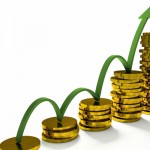The fear pervading investment markets has heightened interest in high-yield stocks. There is much historical evidence that the shares of companies that pay good, stable dividends carry less risk and even deliver better long-term total returns than those focused on capital growth.
However, the most obvious attraction of “equity income” is to those investors who need secure income flows to support their lifestyle, and find the alternatives unattractive.
Bank deposits offer derisory rates of interest. Bonds offer such low yields that in some cases, after adjusting for inflation, they are negative in real terms. Structured products based on derivatives often carry levels of risk beyond the comfort zone of conservative investors.
A well-chosen portfolio of dividend-paying shares, or a fund owning such a portfolio, however, offers:
► Initial rates of income return averaging about 3½ per cent;
► Income that is likely to grow, and do so faster than inflation;
► With low levels of risk.
There are dozens of companies that are categorized as “dividend aristocrats” because they have a history of more than 25 years of consecutive dividend increases.
Dividend yields on many equities beat those of the corporate bonds issued by the same companies, offering both high return and the possibility of future capital growth.
Investors would be wise to plan on the assumption that the world’s economic growth is going to remain subdued for a long, long time, as the dynamic impact of continuing expansion in Asian and other growth economies is offset by sluggishness in the still-much-larger group of debt-burdened mature economies.
That sluggishness will keep central banks under pressure to persist with money-printing policies that keep official interest rates down to derisory levels.
If you are an investor with a need for a secure income flow, don’t assume that yields are going to improve for a long, long time.
Japan offers a paradigm that the world’s other mature economies seem to be following… with chilling implications. A “double bust” of collapsing bubbles in property and banking. Hugely-expensive stimulus programmes paid for by exploding government debt. Money-printing on an unbelievable scale.
Although it isn’t true to say that these policies were a failure in Japan – they did prevent a depression – they were ineffective in producing sustainable economic growth greater than a bare-bones minimum averaging around 1 per cent.
The yield on ten-year Japanese government bonds fell from 5.4 per cent at the end of 199l to 1.35 per cent at the end of 2001 and have declined even more, to about 1 per cent now.
If the other mature economies pursue the same policies as those already tried in Japan, as is happening, it seems just about certain that their investors face the same prospect of very low interest rates for a long, long time.
One of the interesting developments in investment markets is that corporate bonds and credit-risk instruments now often trade at lower rates than those of even the lowest-risk government bonds. In other words, investors rate credit risk in the private sector as less than sovereign risk in the public sector.
If this is true of corporate bonds, it suggests that the risk in the soundest dividend-paying stocks is also lower. Buying McDonald’s shares is lower-risk than US Treasuries – as well as paying higher income.
But what about the risk that such companies will be unable to keep paying dividends at current levels because of a collapse in their earnings, and/or boards decide that they have to hoard cash by suspending/reducing dividends to pay down their debt?
In the Great Depression US dividends did fall by 47 per cent from peak to trough in real terms. However, they did better than corporate earnings, which fell by 67 per cent, and share values, as measured by the S&P Composite Index, which fell by 81 per cent (both in real terms).
Moreover, that was the shorter-term risk, over the period from peak to trough. Over longer periods, dividends have done much better.
In the UK in the worst year of the past half-century, 1998, the Barclays Capital equity income index fell 14 per cent, but it took less than seven years to regain its previous peak. In the US the equivalent index plummeted 47 per cent at the start of the new millennium, yet it took only three years for dividend flows to recover to their previous peak and go higher.
CopyRight – OnTarget 2011 by Martin Spring






